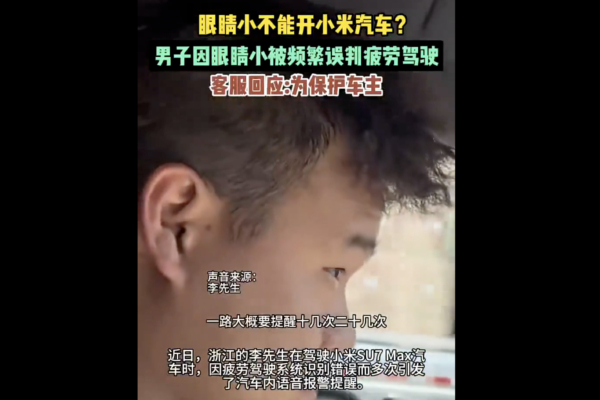Recently, in Zhejiang, a Xiaomi SU7 car owner was frequently misjudged as a fatigued driver by the in-car Driver Monitoring System (DMS) due to having “small eyes”. During a short trip, he received over 20 warnings to “please focus on driving”. This incident sparked heated discussions on social media, with netizens joking that “car owners with small eyes should be cautious when choosing smart cars.” At the same time, the Xiaomi SU7 has recently experienced incidents of “broken axles over bumps” and fatal traffic accidents, raising doubts among the public about its product quality and the safety of its intelligent driving system.
Mr. Li, a car owner in Zhejiang, was repeatedly misjudged as a fatigued driver by the Xiaomi SU7’s in-car DMS system due to his “small eyes” while driving. During a short trip, the system warned him to “please focus on driving” more than 20 times. Mr. Li stated that his driving condition was normal, and even intentionally widening his eyes couldn’t prevent the reminders. The video of this event quickly spread on social media, sparking discussions among netizens, with some joking that “car owners with small eyes should think twice before driving a smart car.”
Xiaomi Automotive customer service responded that the DMS system is a standard safety feature for each car and may misjudge due to being overly sensitive. Customer service suggested that users could manually turn off the alert function but emphasized that it’s not recommended for safety reasons. In fact, similar misjudgments are not unique to Xiaomi. In 2022, a Xpeng car owner was deemed a fatigued driver by the system due to having “small eyes”, which led to the inability to use the Navigation Guided Pilot (NGP) function, garnering widespread attention at the time.
Currently, mainstream DMS systems capture facial images through cameras and determine the driver’s state based on indicators such as eye opening/closing and head posture. However, due to limitations in algorithm models, hardware performance, and lack of diversity in training data, the system’s accuracy in scenarios like “small eyes”, squinting in bright light, or wearing sunglasses is lower.
In fact, Chinese electric car brands like Lantu, NIO, etc., have also experienced similar misjudgments. To improve accuracy, companies like Tesla have adopted multiple verification mechanisms to reduce misjudgment rates, whereas the recent turmoil surrounding the Xiaomi SU7 indicates room for improvement in algorithm optimization and hardware calibration.
In recent times, the Xiaomi SU7 has been involved in two highly publicized safety incidents, raising doubts about its product quality and the safety of its intelligent driving system. In February, a car owner reported that the vehicle experienced “axle breakage” after passing through a bumpy road section.
Xiaomi Automotive later clarified, but the car owner’s social media account was suspended, leading to further speculation among netizens about the authenticity of the incident. Some experts pointed out that “limited damage to the rear axle hub after a tire blowout is unusual, but arm breakage is inconsistent with conventional mechanical logic.”
A more severe accident occurred in March, where a Xiaomi SU7 in Anhui Tongling lost control in the “Navigate on Autopilot” (NOA) intelligent driving mode, crashing into a guardrail, catching on fire, and tragically resulting in the death of three female university students inside the vehicle.
Xiaomi Automotive stated that the vehicle’s Automatic Emergency Braking (AEB) system operates within a speed range of 8 to 135 kilometers per hour and cannot identify obstacles like traffic cones, water barriers, or rocks. The company has yet to provide a clear explanation for the door lock failure and fire cause.
Insights from experts in the intelligent driving industry suggest that the accident may have occurred due to system delays in recognizing front obstacles, leading to the AEB not activating promptly. The perception capabilities of current intelligent driving systems still have limitations, especially in dealing with non-standard obstacles. Some mainland media articles have pointed out that some marketing of “intelligent driving” may be exaggerated, becoming a “bubble myth” in the capital market.
The series of incidents involving the Xiaomi SU7 not only impact its brand reputation but also prompt the industry to reevaluate the safety and quality control standards of electric vehicle intelligent driving systems. After the accidents were exposed, Xiaomi Group’s stock on the Hong Kong Stock Exchange plummeted for two consecutive days, with a market value evaporation of over 120 billion Hong Kong dollars, facing its most severe trust crisis since its establishment.
The series of events surrounding the Xiaomi SU7 highlights the challenges of current intelligent driving technology. The misjudgment issue of the DMS system reflects inadequacies of algorithms in adapting to diverse populations, while incidents like “axle breakage” and fatal accidents expose issues of product quality and the reliability of intelligent driving systems in extreme scenarios.
The ongoing incidents have stirred discussions on the supervision of the Chinese automotive industry. However, the Communist authorities have focused their regulatory efforts on online opinions such as self-media, with the Cyberspace Administration having previously issued multiple statements prohibiting “slandering or defaming corporate and entrepreneur image reputations”. With strong support from the authorities, several car companies like Xiaomi, BYD, claim to have encountered “online violence”, either publicly offering rewards for related clues or directly suing relevant self-media and automotive bloggers, with court rulings tending to favor the car companies.

